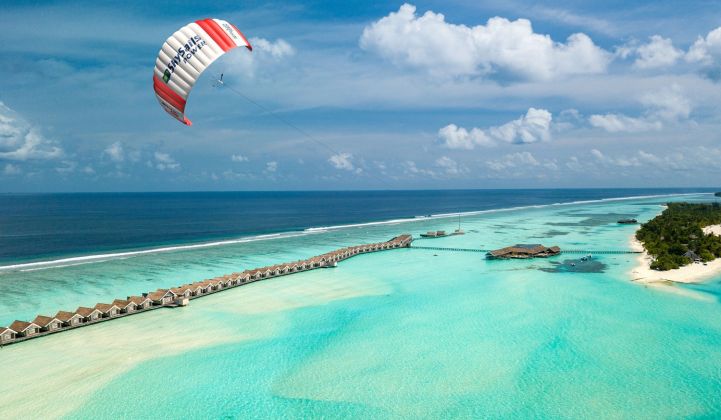An energy technology that even Google parent company and tech behemoth Alphabet couldn’t get to work might finally achieve commercial takeoff this year.
The German company SkySails Power last month announced that its energy kite concept would be taking to the skies this year on the Indian Ocean island nation of Mauritius. This could move airborne wind closer to commercial success than Alphabet-backed airborne wind power technology developer Makani was able to get before it crashed out of the market last year.
“Starting in 2021, a large kite will lift off at the eastern coast of the island to generate electricity for the CEB [Central Electricity Board] grid from high-altitude winds,” SkySails stated in a press release.
The project is for Mauritian-based IBL Energy Holdings and is supported by a national scheme for emerging renewable energy technologies tendered by the CEB along with the Mauritius Renewable Energy Agency and the Mauritius Research Council, the release says.
“The Republic of Mauritius is targeting a 40 percent share of renewables in its electricity mix by 2030,” SkySails commented. “Thanks to its specific advantages, airborne wind energy is set to play a vital role in achieving this objective.”
SkySails Group marketing lead Nina Grossmann told GTM in an email that installation in Mauritius would take place during the Northern Hemisphere's summer months. SkySails is also due to announce another sale in the coming days, she said.
“These are pre-series units delivered to reference customers,” Grossmann added.
Wind kite companies race to commercialization
SkySails is not the only airborne wind energy player closing in on commercial operations. The Dutch developer Kitepower, for example, has been taking preorders for its 100-kilowatt Falcon airborne wind platform for around a year.
"We have now started field operations in a new location within the Netherlands," said Marcello Ghilardi, head of PR and communications, in an email. A December web posting said Falcon test results last year “were beyond our simulated expectations.”
As was the case with Makani, SkySails and Kitepower are aiming to produce energy using a tethered flying device that can capture winds at altitudes of up to around 2,600 feet.
Beyond accessing steadier, stronger winds, such devices are hypothesized to be cost-competitive with traditional turbines because they do not require towers or massive blades.
SkySails, for example, is targeting a levelized cost of energy (LCOE) of 40 euros ($49) per megawatt-hour once it moves to serial production.
This is within the $26 to $54 range for onshore wind in Lazard’s latest LCOE analysis, released last October, and comfortably below the $86 per megawatt-hour level for offshore turbines.
Makani’s failure casts a pall over the viability of airborne wind
About two dozen companies and as many academic teams have worked on various approaches to airborne wind over the years, with Makani long seen as the leader in the field after it was adopted by Google’s parent company.
But Alphabet dropped Makani in February last year, fueling speculation over the viability of airborne wind in general. Makani had spent 13 years trying to develop a viable energy kite, and for five of those years, it was able to draw on the resources of one of the world’s largest companies.
In February 2019, Makani partnered with another corporate colossus, Shell, to investigate using energy kites in offshore environments. When Alphabet severed ties with Makani a year later, it looked as though Shell might continue to develop the technology.
But the petrochemical giant, perhaps affected by the impacts of the 2020 oil pricing war and coronavirus pandemic on its core business, also ultimately abandoned Makani. The kite developer shut down permanently in September. (GTM approached Shell for comment, but the company declined as it is in a pre-results closed period.)
Was Makani trying to achieve too much, too soon?
Before shuttering, the long-secretive Makani made all its airborne wind know-how available online. The documentation includes a 1,180-page, three-volume technical report covering everything from flight test results to bird and bat conservation plans.
The report reveals that even after more than a decade of development, the team at Makani was still grappling with unresolved problems.
For example, according to systems engineer Nicholas Tucker, “Much of the focus in the [airborne wind turbine] literature and [horizontal-axis wind turbine] design has been on making as much power as possible. [...] However, the challenges of what happens beyond that point, as wind speed continues to increase with a saturated power system that is unable to accept any additional power, cannot be overlooked. High-wind operation and power saturation remained an unsolved problem at Makani.”
Simpler designs will need to prove their worth
It is indisputable that at the end of its run Makani was trying to achieve a highly complex engineering feat.
In a forward to the technical report, then-CEO Fort Felker said: “Challenges of scale, both in terms of development time and cost and in terms of the deployments needed to make a difference, led Makani to make bold decisions. We increased the power capacity and size of the kites in huge steps, we rapidly pushed into difficult operational environments, and we took on new challenges without waiting for all the answers to our prior challenges.”
This has led observers to question whether simpler designs, such as those being pursued by SkySails, Kitepower and others, might stand a better chance of success.
The coming months could provide an answer, although for now the prevailing view of airborne wind is perhaps best summed up by Brian Gaylord, principal analyst at Wood Mackenzie.
“We were monitoring the progression of Makani before it ultimately folded earlier last year,” he said in an email. “This, however, was primarily due to its backing by Alphabet and not necessarily [because] we inherently [regard] airborne turbines as commercially viable.”




